The most common political party for new voters is no party at all | Weekly roundup for August 24, 2025
Also this week: Voters oppose Trump's federalized police crackdowns; Musk backs off his third-party threats; Americans worry about democracy; and more
Dear readers,
This Sunday, I offer some commentary on the New York Times’ big voter registration analysis, which I think underplayed a big story: the long‑term, substantial shift away from America’s two major parties. I also touch on other major stories of the week, including gerrymandering in Texas and California and Trump’s militarized police crackdown in Washington, D.C.
On deck this week: Our August Strength In Numbers/Verasight poll (Tuesday), and the August Q&A (Thursday). If you have any lingering topics for the Q&A, email me or comment below! Last chance!
As always, if you have thoughts or other data to send around/a story of yours for me to feature, my email is contact@gelliottmorris.com.
The big NYT party registration story
1. Leading or lagging indicator?
The New York Times made quite a splash with a fresh analysis of state-by-state party registrations this week. Reporters Shane Goldmacher and Jonah Smith write that “Of the 30 states that track voter registration by political party, Democrats lost ground to Republicans in every single one between the 2020 and 2024 elections — and often by a lot.”
They write that in 2024, new registrants leaned GOP “for the first time since 2018” and “Democrats held a roughly 517,310 registration advantage among active voters in Pennsylvania in November 2020, according to state records, but that edge dwindled to 58,530 voters this summer.” In North Carolina, the Democratic edge is now just 17,000 votes, compared to nearly 400,000 in 2020.
So here’s where I add my take. First, the trend is undeniably bad for Democrats. It’s possible this is the worst 4-year decline in registration for either party over the last 20 years. At the same time, I’m not sure if we are learning anything shockingly new with this analysis: voter data showed the party losing ground last year, and of course the Democrats lost 6 points in popular vote margin from 2020 to 2024. Of course their voter registration numbers took a beating too! So should the new data cause us to massively update our priors?
But the voter data does raise an interesting puzzle for us to solve: The party registration statistics cited by the NYT imply that across NC and PA, Democrats lost over 800,000 voters from 2020 to 2024. However, over that time period net Democratic votes in the presidential election “only” fell by 300,000 — less than half the size of the shift in registration.Maybe if everyone voted, the net decline would have been larger?
Maybe, but I don’t think that’s what’s going on. Looking within years, you can see there is a sizable share of the population that is Democrat In Name Only. Joe Biden lost North Carolina by ~75,000 votes in 2020 (while having that 400k-voter advantage) and won in Pennsylvania by just ~80,000 (despite the 517k lead).
And there’s more to the puzzle: Democrats have held an advantage in party registration in North Carolina for the past 40 years. It was 30 points at the beginning of the century. For most of this period, many of those “Democrats” by voter registration have been Republicans by vote choice. In 2012, Obama’s vote share was 20 points behind the Democratic Party registration advantage in North Carolina.
What’s happening is that many of these registered “Democrats” changing their party registration were not previous Democratic voters. This is not uncommon, especially in the South where there is a high proportion of so-called “ancestral Democrats” — people who are registered as Democrats due to local and regional historical factors but now vote Republican.
So hidden in the toplines of the NYT’s math is a combination of (1) “ancestral Democrats” both aging out of the electorate and changing their party registration to match their newer identities (and vote intention), (2) other genuine Democratic voters changing their label to Republican or No Party because they’re unhappy with the Democrats, and (3) real Democratic struggles recruiting new voters.
So there is quite a large mismatch between the Democratic lead in registration and how this translates to voting. Obviously, a decline in your registered voter base is not good no matter the reason — but depending on the reason, it’s also, evidently, not a death knell. At least not yet.
2. The rise of non-partisan and minor-party voters
The other thing to address is the growing trend of new voters identifying as neither Democrat nor Republican. According to the Times, just 24% of new voters nationwide in 2024 registered as Democrat, while 29% identified as Republican. That leaves 47% who registered without a party or with a minor party (such as e.g., Green, Socialist, Libertarian).
If you ask me, this is a trend worth diving into as well. The most common party registration in America is not with either of the two major parties, but explicitly against them both. Democrats should be worried about their recent political headwinds, but Republicans should be thinking about their shrinking position as well. The act of registering against both major parties reveals something about the psychology of the public. A deep sense of frustration with politics is leading to a systematic shedding of major-party political identities in voters’ psyches, and a growing appetite for minor-party candidates.
And this trend does not show any signs of slowing down.
I loaded up the L2 voter file on my computer and looked at the party breakdown of all the new voters who have registered since November 6, 2024. In Pennsylvania, 33.7% of new registrants chose Republican, 33.3% chose Democrat, and 33.0% chose no or a different party. In North Carolina, the breakdown of new voters was 51.2% no party/other, 27.2% Republican, and 21.6% Democrat.
I think it is notable that the Times analyzed these data through the horse-race angle, focusing on which major party was up or down. The reporters focused on the margins between registration percentages, but there seems to be an equally important story about the percentages themselves just waiting for anyone willing to see the data through a different lens…
What you missed at Strength In Numbers
Subscribers to Strength In Numbers received three articles over the last week:
First, here is my analysis from Friday of how the new partisan gerrymanders in Texas, California, and other GOP-run states could impact next year’s midterms.
On Tuesday, I published this long article about uncertainty in models of candidate quality (“Wins Above Replacement”), discussing what we can and cannot know about the supposed benefit of being an ideological moderate in elections.
And finally, last Sunday’s weekly roundup is here:
If you’d like to receive more subscribers-only posts and support independent data-driven journalism, become a paying member of Strength In Numbers today. Prorating the cost of a subscription over the monthly number of posts we publish, paying members effectively get each of these articles for 50 cents each. Your support means a lot to me and will help the business grow!
Even more numbers!
A collection of links from the last week:
I was interviewed for this article in the Columbia Journalism Review on Trump’s attacks on polling. The piece is by some former colleagues of mine and I think it’s quite good!
WaPo has a good updating map of where federal law enforcement is patrolling in DC. It’s not where the crime is.
WaPo also published a poll of DC residents finding 65% don’t think Trump’s police crackdown will make DC safer.
A Data for Progress poll found voters nationally also oppose Trump’s police crackdown in DC, and are worried about what he will do in other cities.
Nate Cohn and Eve Washington explain why the U.S. House map in Massachusetts (which has no Republicans despite 36% of the state voting for Trump) is not gerrymandered, but rather inherent to America’s use of single-member districts. Time to move to a new system!
A Reuters/Ipsos poll finds 55% of voters think partisan gerrymandering is “bad for democracy,” and 57% fear that U.S. democracy itself is in danger.
Trump’s disapproval rating hits a new high in YouGov’s data.
And Ipsos finds elevated concerns about inflation — something I pointed out using YouGov’s trends last week.
Elon Musk dropped his threat to start a third party, saying polls suggested it would take more votes from Republicans than Democrats. I raised this issue with his plans when covering our Strength In Numbers/Verasight poll last month.
Voters in California support Democrats’ new gerrymander, 48% to 32%. If remaining voters split 50-50 or proportionally, that should be enough to carry the maps over the line in November’s special election.
Finally, here’s something fun: A Pew poll on the behaviors that people find rude (such as cursing in public). You can take a quiz to figure out if you’re polite — let’s just say I’m quintessentially Texan.
Updates from the data portal
Trump approval:
Trump issue approval:
House generic ballot average:
The charts on the data portal update every day. Feel free to use and cite them liberally!
That’s it for your major political data stories this week.
Got more for next week? Email your links or add to the comments below!
Have a nice week,
Elliott



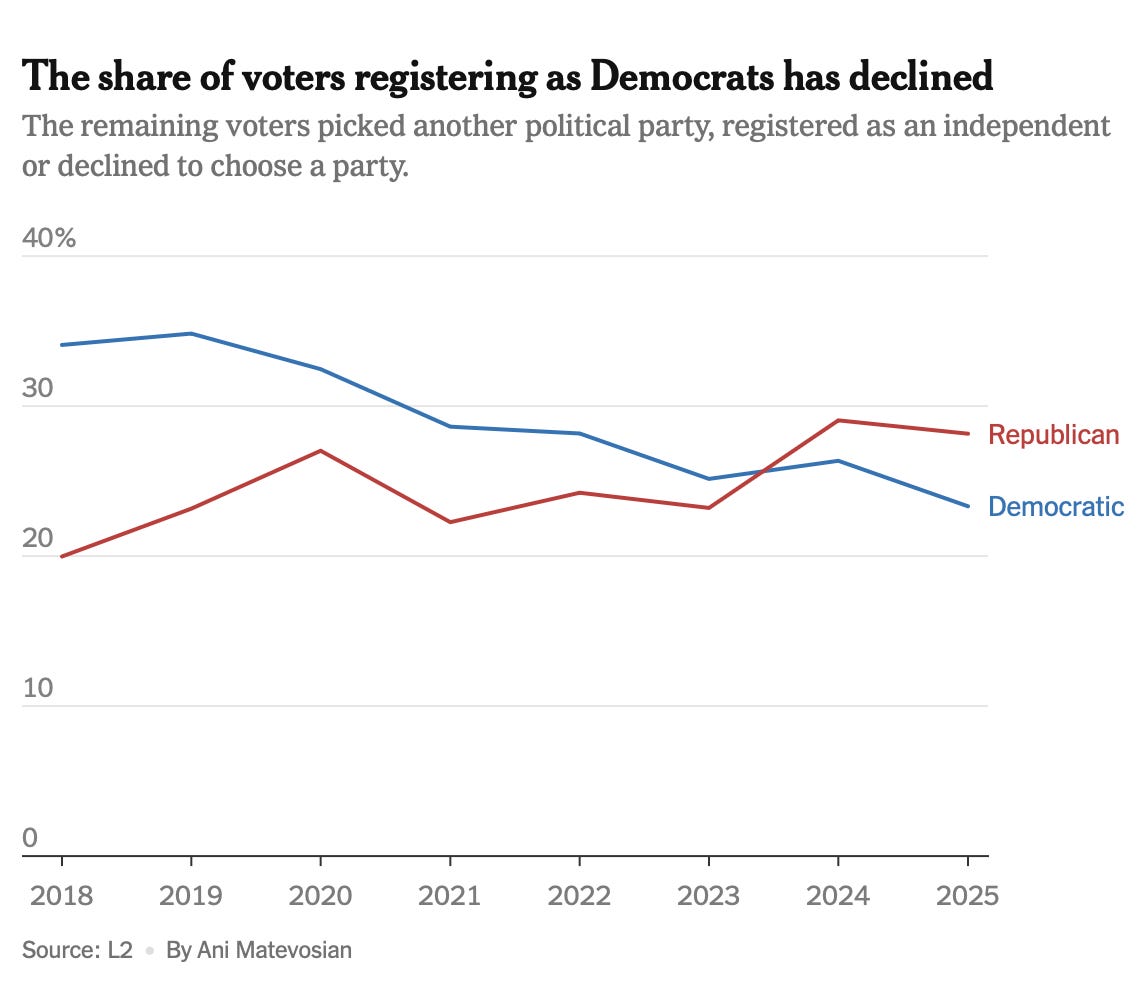

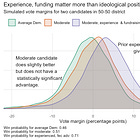
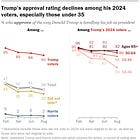
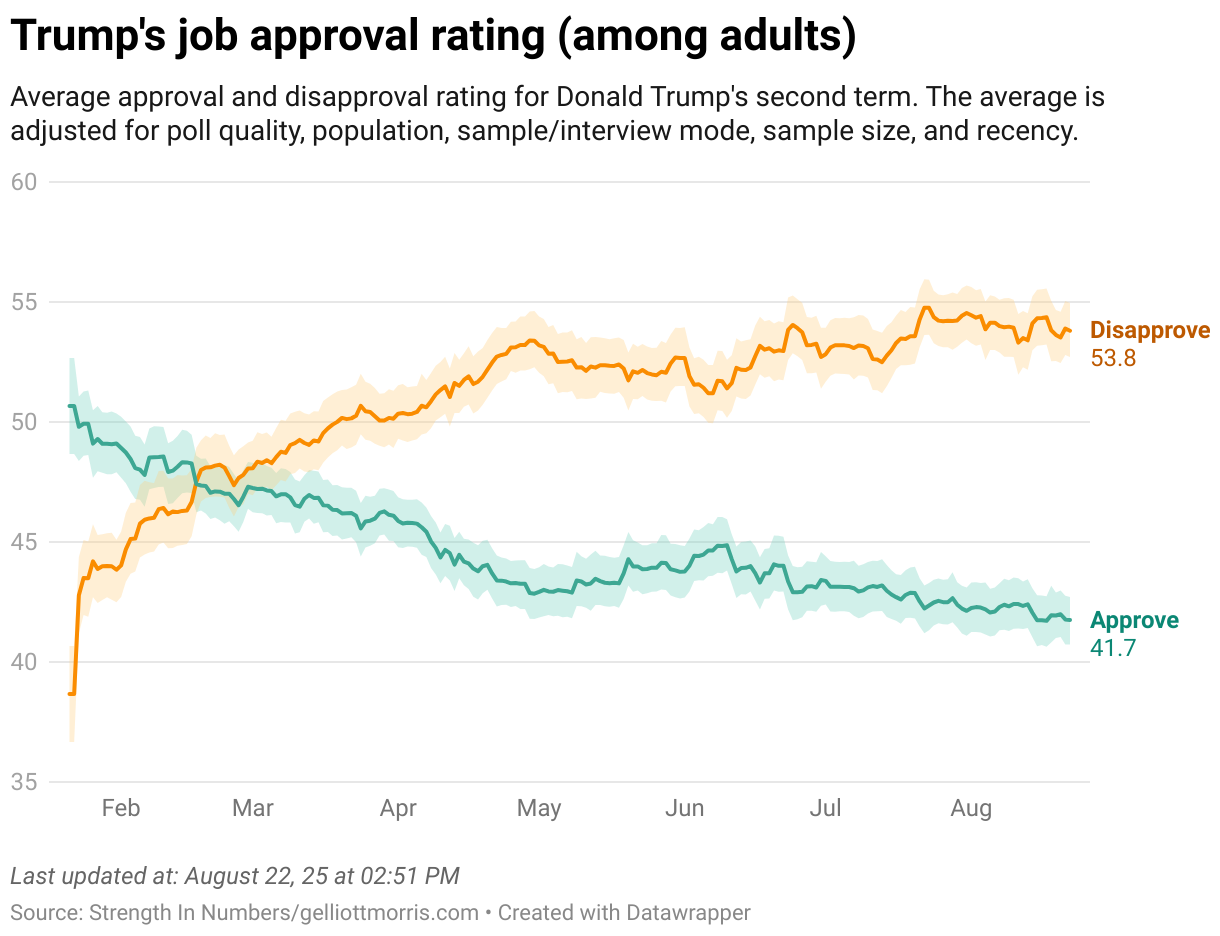

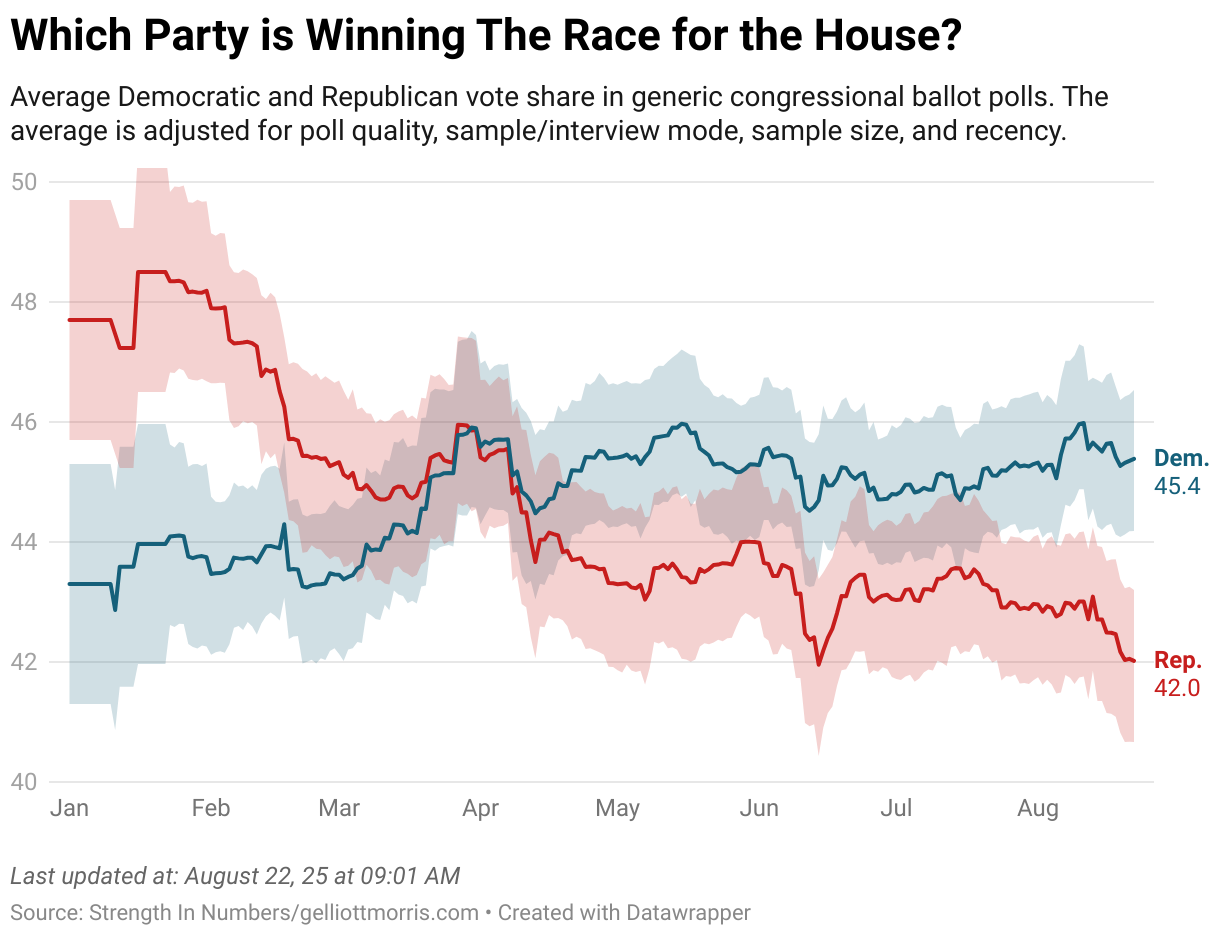
⬆️"In North Carolina, the breakdown of new voters was 51.2% no party/other, 27.2% Republican, and 21.6% Democrat."
I'm a North Carolina resident (and voter) who is involved with several groups doing voter registration. The Democratic party has been doing very litle voter registration itself, leaving it to nonpartisan groups like League of Women Voters (www.lwv.org), Indivisible (www.indivisible.org) and (in NC) You Can Vote (www.youcanvote.org).
Volunteers with these groups are cautioned NOT to advocate for a specific party registration, so we usually leave it at saying that party registration is optional and that if you don't check a box you will automatically be listing as unaffiliated. Then we explain that since NC has a semi-closed primary system, people registered as unaffiliated can still vote in primaries by selecting one party's ballot when they check in at the polling place.
Finally, voter registration is considered a public record and in NC you need very little information to look up someone's registration data. Unless they have a very common name, their name and county of residence will do it. So it would be prudent to register as unaffiliated for any young person more progressive than their families and/or their community.
Is it any wonder that the majority of new registrants don't select a party in NC?
The fact that voters are staying home is far more concerning to me than that more new registrants are registering as Republican than Democrat when they do pick a party when they register.
By midterms I think the party names are just a formality pushing the illusion that everything is normal.
In reality we’ll only have two choices as voters:
Pro-government that we pay for working FOR the people?
Pro-Trump government that we pay for weaponized AGAINST the people?
I don’t understand how voters can’t see that this is it.
And Democrats need to minimize and unify their messaging. Stop sounding like programmed politicians and start sounding like battlefield commanders! We have to unify people from the far left, moderates, independents, to constitutional conservatives IF we want to win in 2026. What’s equally important to everyone in these groups?
A good economy
Lower Inflation
Constitutional rights and freedoms.
Veterans benefits
Medicare for our parents
The country being safe from attack.
Prescription drug prices….
Not sure why Dems are struggling so with their messaging.